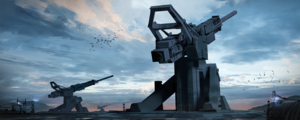HALOS (Hyboria)
| Rifle, 48-inch, M8 | |
|---|---|
 3 examples shown on Barbette Mount M13 | |
| Type | Low-orbital hypervelocity asteroid interception and air and ballistic missile defense |
| Place of origin | Hyboria |
| Service history | |
| In service | 1987- |
| Used by | Hyboria |
| Wars | Omandan Continental War |
| Production history | |
| Designer | Dr. William Atkinson |
| Designed | 1970 |
| Manufacturer | Various |
| Unit cost | 20 Billion dollars |
| Produced | 1982-1990 |
| No. built | 8 |
| Specifications | |
| Shell weight | 12 tonnes |
| Caliber | 1,200 mm (47 in) |
| Elevation | +80° -15° |
| Traverse | 360° |
| Rate of fire | 1 round every 5 minutes |
| Muzzle velocity | 6 km/s (20,000 ft/s) |
| Effective firing range | 1,500 km (930 mi) |
| Maximum firing range | 2,000 km (1,200 mi) |
| References | |
The Hyborian Anti Low Orbital System, also known as HALOS or by its project name, Project Stonehenghe is a low-orbital hypervelocity asteroid interception and strategic air and ballistic missile defense system developed and built in Hyboria. The system was developed initially to combat low-orbital debris and asteroid impacts following the planetfall of the Ulysses Asteroid in 1913 and the subsequent years following. During the events of the Omandan Continental War its use as an anti-air and missile defense system was also unveiled. Upon entry in early 1987, the HALOS was used against a large formation of Transnapistani bomber aircraft using a low-yield nuclear munition, the existence of which had been kept a secret to the world. The guns would go on using their standard ammunition for engagements until the 1994 nuclear exchange. Then the system would also show its use as a ballistic missile defense system, shooting down Transnapistani MRVs with their low-yield nuclear shells, greatly reducing effectiveness of the nuclear strike on Hyboria.
It is the largest artillery gun in the world, uses the largest supercomputer in the world and is the only major operational light-gas gun in service in the world.
Development and design
On April 16th, 1913, the Ulysses Asteroid, named after the physicist Samuel Ulysses who had discovered the asteroid a mere twenty days before it began its breakup over Annwynn. The asteroid is suspected to have been loosely held together and made up mostly of frozen water, as once it began to come into orbit with Annwynn, it broke up almost instantly. The asteroid is estimated to be roughly 12 kilometers (7.4 mi) in diameter, and made up mostly of carbon and water, with large amounts of sulfur, arsenic, lead, and mercury present as well. It was possibly the size of the first asteroids that impacted Annwynn millions of years ago, causing the mass-extinction events of the time. However instead the asteroid began to break up upon entry into orbit and even more as these fragments began to push through the atmosphere. Unlike the asteroids from millions of years ago as well the Ulysses Asteroid came towards Annwynn at a very shallow angle, allowing for much of the fragments to break off and enter into the rotation and set into a slow descent onto the planet.
The impacts were world-wide, however the majority took place over the continent of Hyboria. The resulting impacting fragments ranged between a few meters to the largest being over 300 meters. The largest of these fragments exploded over the capital of the Republic of Jothain, Harthampton. The resulting explosion is estimated by modern experts to be over 15 megatons of TNT in strength, equivalent to the nuclear weapons used by the Hyborian Federation in the later stages of the Omandan Continental War. Much of the city was destroyed, with over 100,000 people killed in the initial blast, with tens of thousands more dying over the next few days.
Construction
Combat use
Ammunition
- Projectile, 48-inch: Test, M800: Initial test projectile used in the mid-1980s. M800, M801, M802 and M803 were all test projectiles used to prove the design
- Projectile, 48-inch: Test, M801
- Projectile, 48-inch: Test, M802
- Projectile, 48-inch: Test, M803
- Projectile, 48-inch: Dummy, M804: Training munition used in cycling the reloading system, based on final design of the M803
- Projectile, 48-inch: High-Explosive Asteroid-Penetrating, M805 (HEAP): First model shell used to engage asteroid fragments, used to a limited role against massive aircraft formations. Improved into the M805A1 model. Replaced by the M807 I-HEAP round. Used in over 129 interceptions of asteroid fragments.
- Projectile, 48-inch: Artillery Fired Atomic Projectile, M856 (AFAP): First type of nuclear munition developed, used the W56 warhead with a 1.2 megaton yield. Was considered for use in both anti-air, BMD, and also in the anti-ground role. Was never used, less than 20 produced and all decommissioned by 2010. Designation of M856 was given as it used the W56 warhead.
- Projectile, 48-inch: Artillery Fired Atomic Projectile, Anti-Aircraft, M862 (AFAPAA): Used the W62 thermonuclear warhead with a yield of 170 kilotons. Used multiple times during the OCW. Total number produced is classified, possibly over 400 rounds. Production is ongoing with the improved M862A1, taking advantage of improvements applied to M807.
- Projectile, 48-inch: Atmospheric Testing, M806 (AT): Used for atmospheric testing experiments.
- Projectile, 48-inch: Improved High-Explosive Armor-Piercing, M807 (I-HEAP): Improved model of shell produced by the end of the OCW, did not see service during. Current in-production shell.
- Projectile, 48-inch: High-Explosive Armor-Piercing, Rocket-Assisted, M808 (HEAPRA): New shell in development or already in service, range is reported to be "greatly extended".